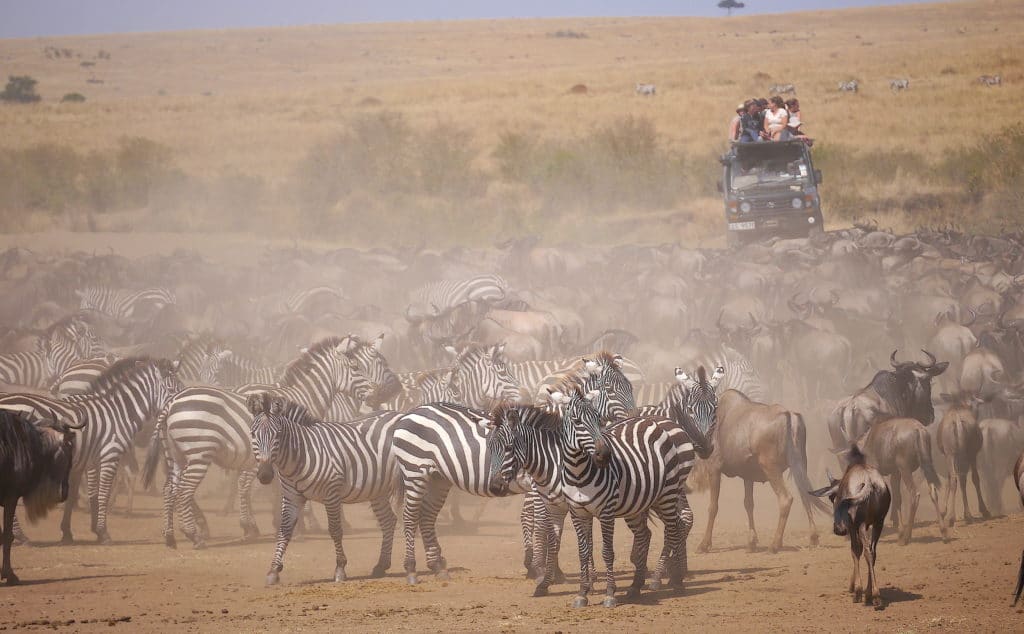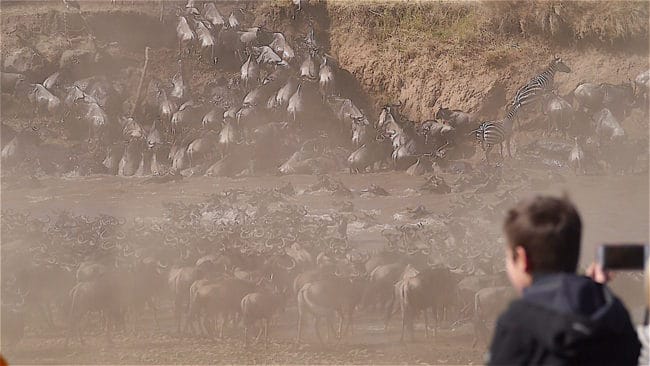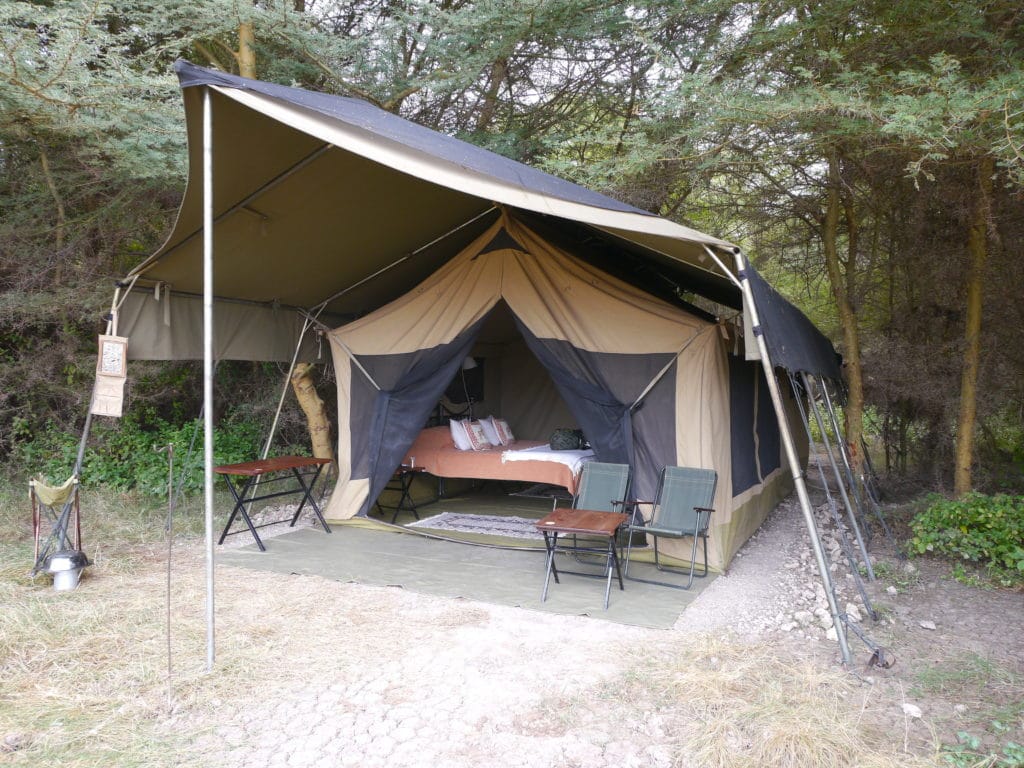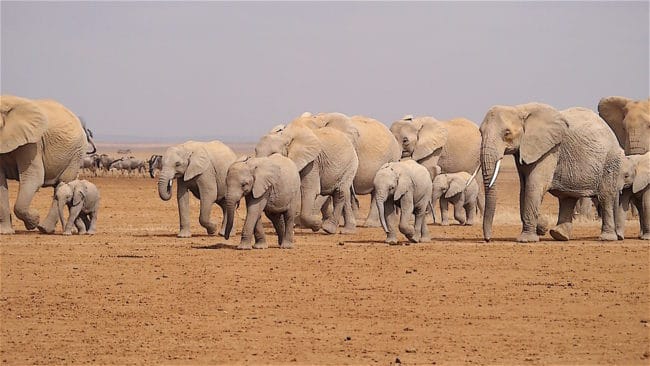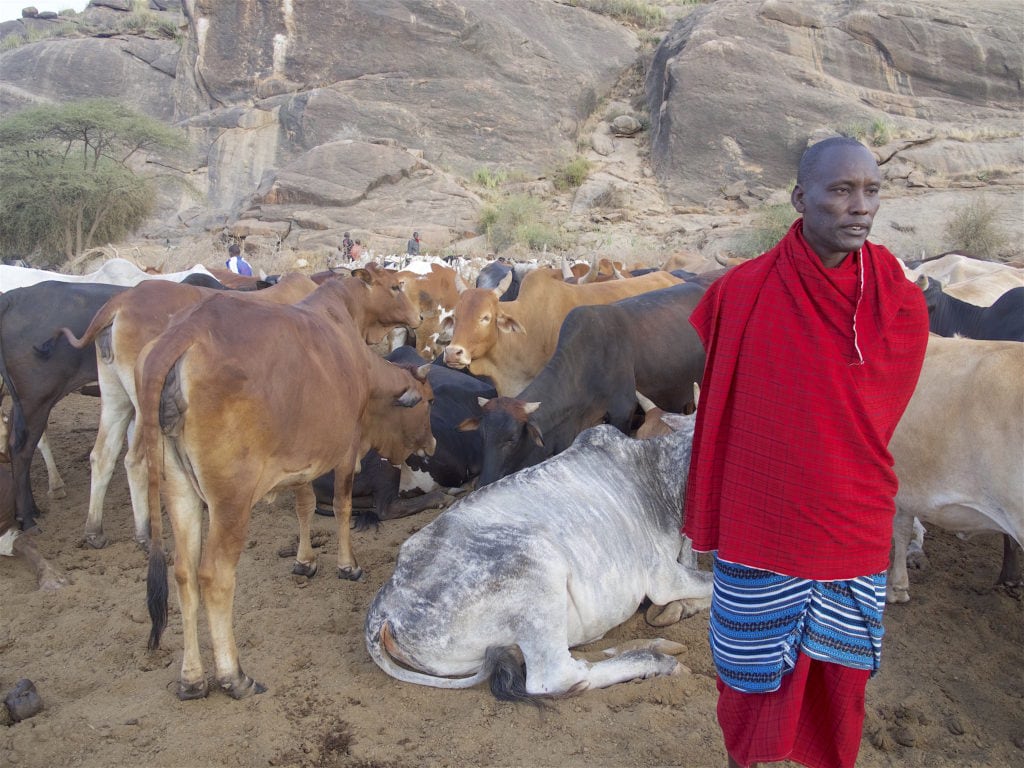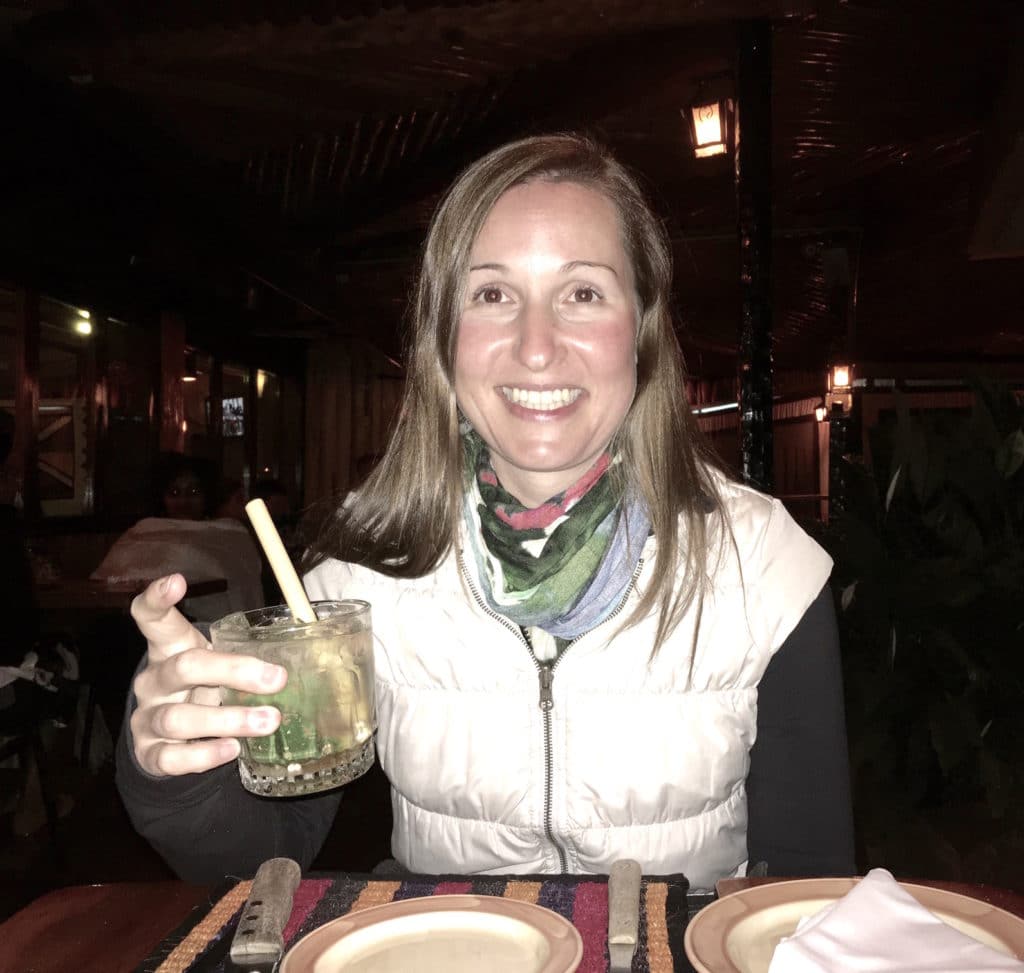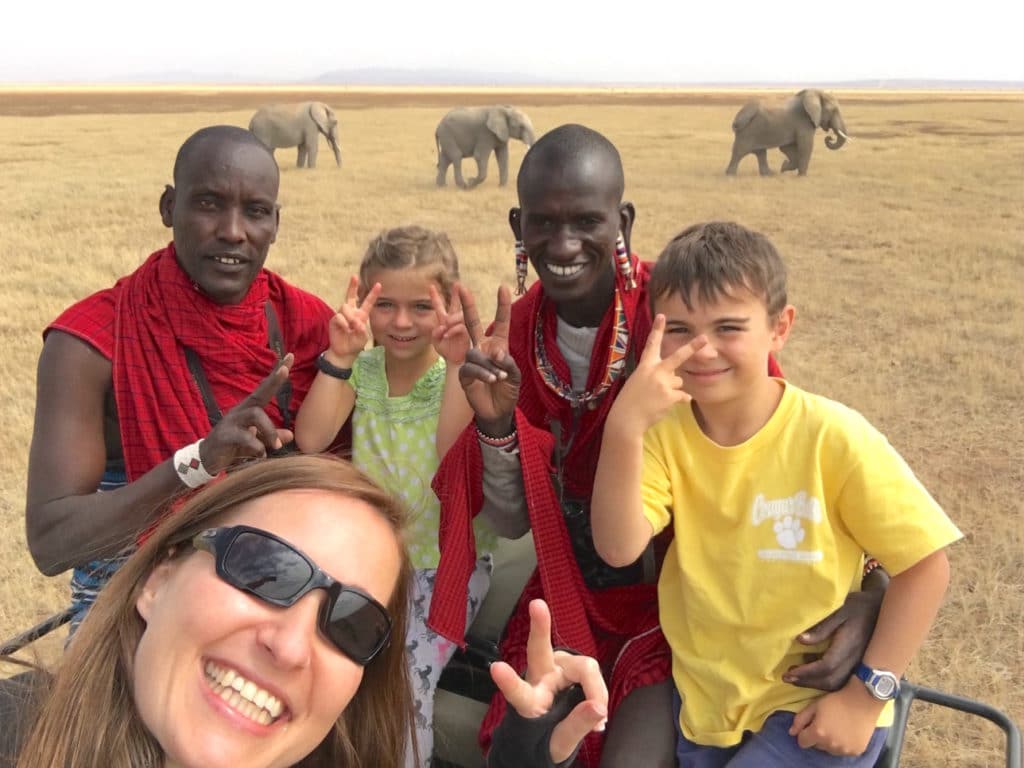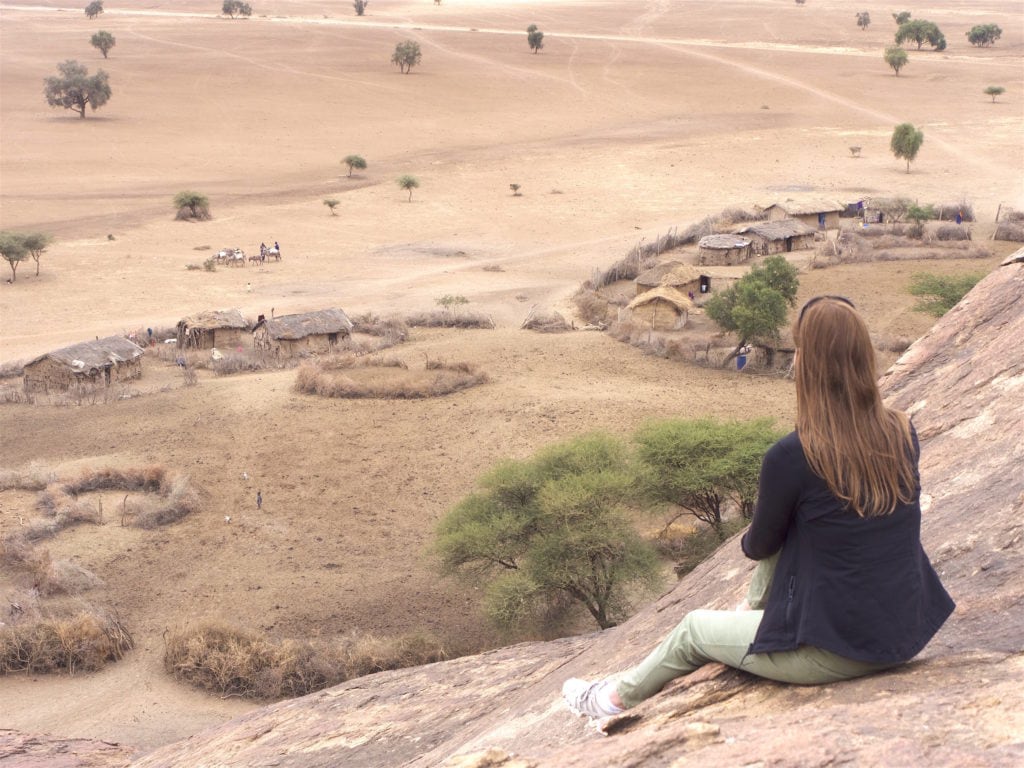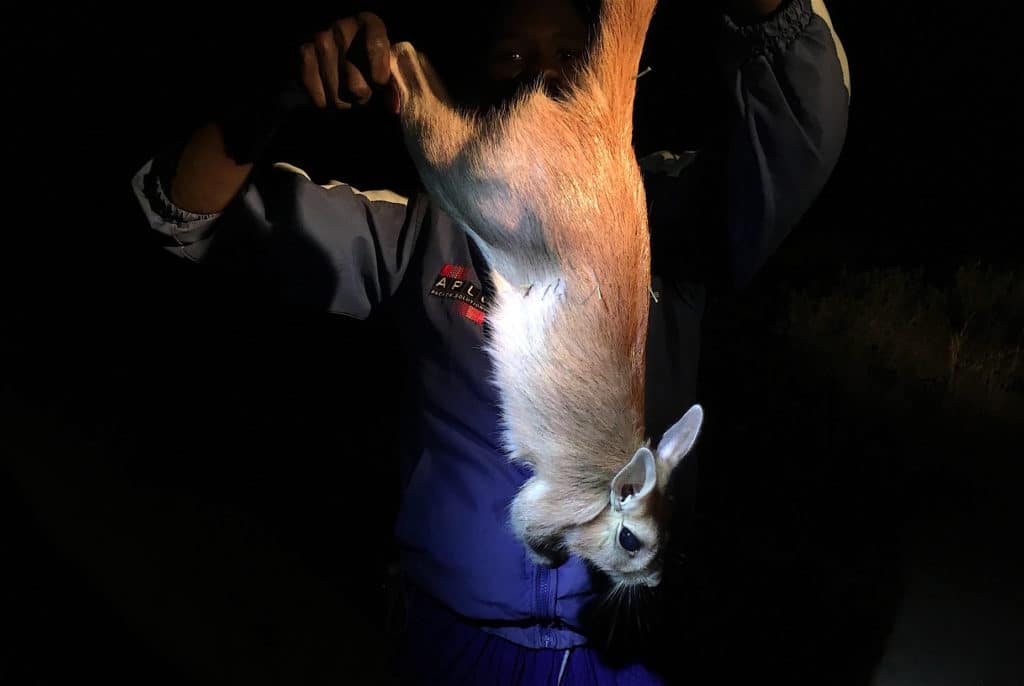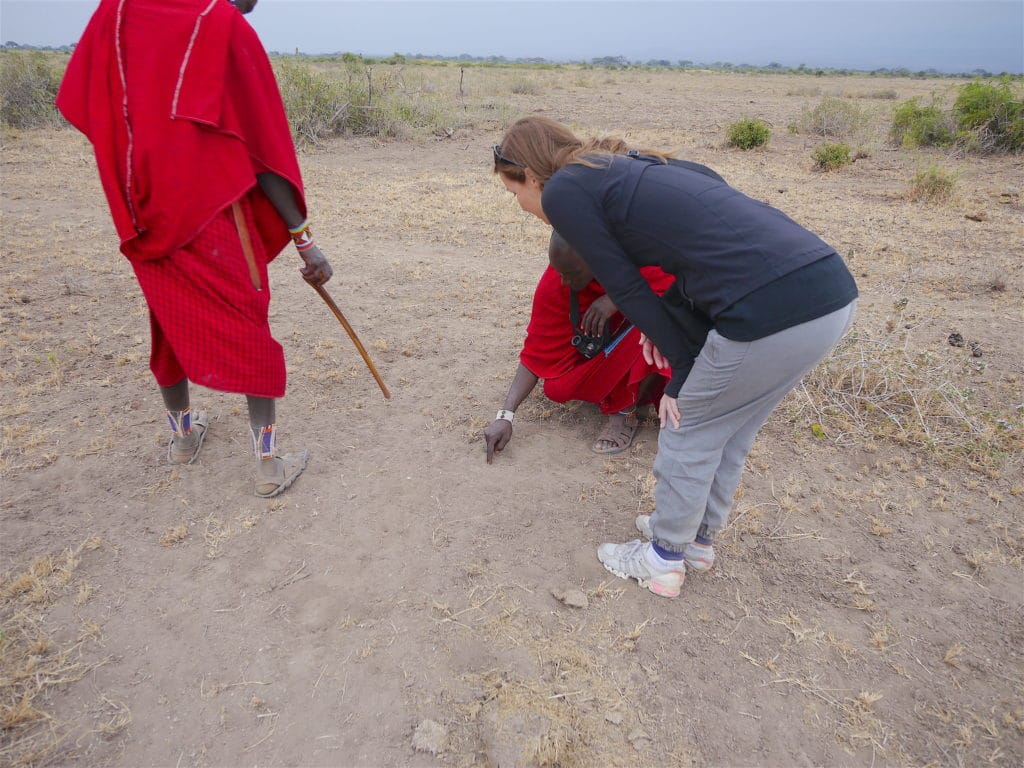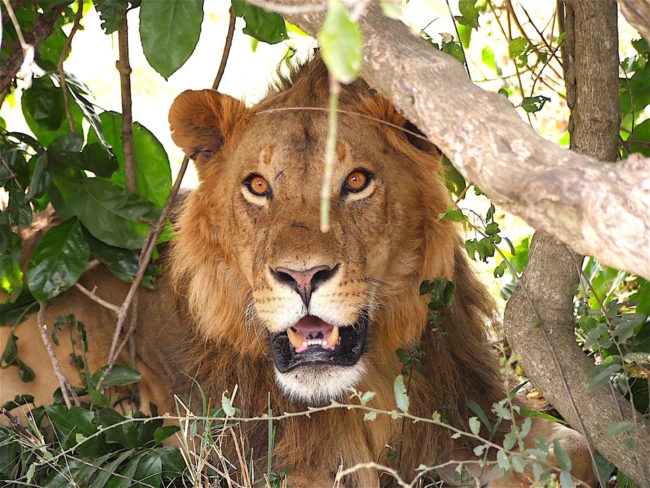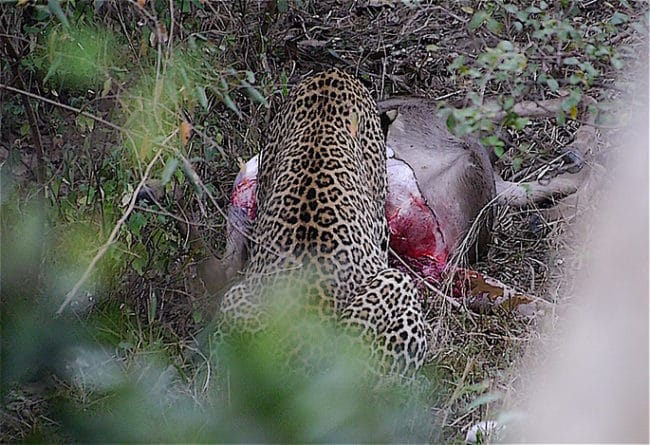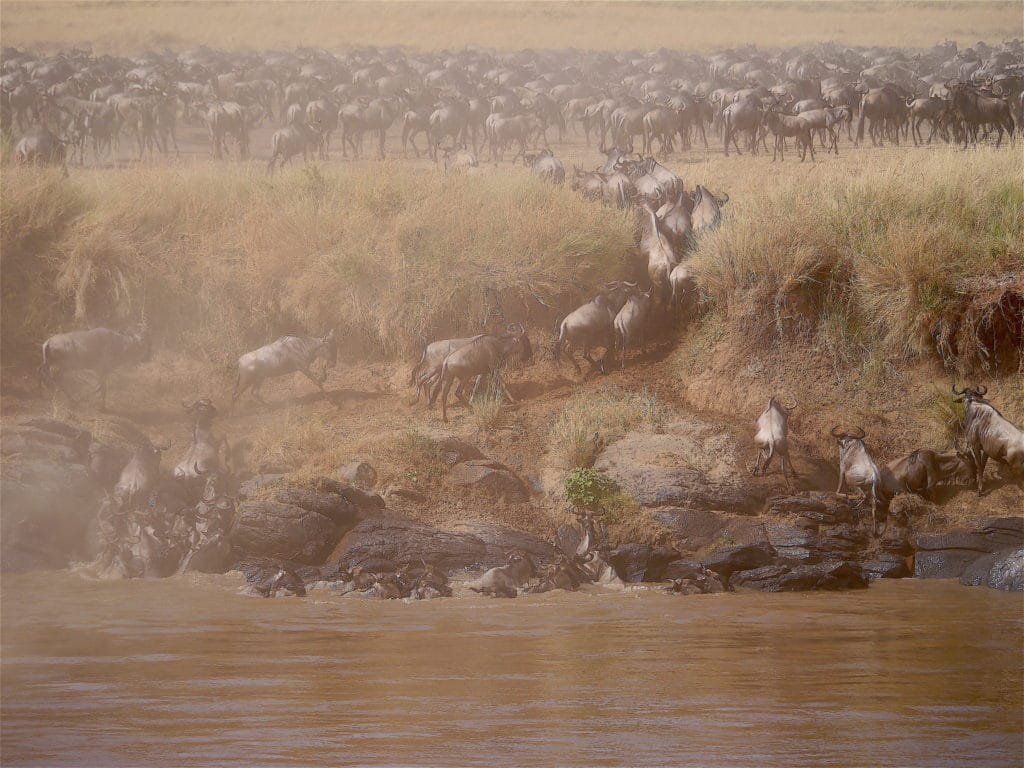In my search for the lesser visited parks across Africa, I forfeited the idea of tracking wildlife in the famous East African parks of Serengeti and Maasai Mara. Until 2016. Eventually, the sighting of The Great Migration won me over and I decided to book a safari to witness this spectacle of nature. But planning a Great Migration safari is not easy. There are a lot of considerations, from what park to visit to where to stay. Let me help you plan your Great Migration safari based on my previous experiences.
What is The Great Migration
The Great Migration occurs every year between the months of June to September when thousands of wildebeest and zebra move from the Serengeti to the Maasai Mara and back in search of greener pastures. The most iconic images captured by National Geographic and other famous outlets are those of thousands of the animals crossing the Mara River and being eaten by expecting crocodiles.
The intense concentration of wildebeest, zebra and other antelopes, reaching over 1.5 million, attracts other predators. Seeing lions, leopard or cheetah making a kill is extremely likely and makes for the greatest spectacle of nature as the evolutionary theories and the balance of the eco-system are revealed in their full glory.
But, the otherworldly concentration of wildlife and the dry weather conditions in the plains (which makes it easier to spot wildlife) make this time of the year the highest of the peak season. The amount of wildlife is such that, despite the popularity and the high occupancy at the many lodges and camps, it is still possible to enjoy many of the sightings without another car for company.
A luxury mobile tented camp
Much like the very first safari goers, big game hunters and Hollywood celebrities, one of the most unique, exclusive and private ways to explore Kenya and Africa, is on a mobile tented camp.
Having stayed at several luxury lodges like Elsa’s Kopje, &Beyond Sossusvlei Desert Lodge, Hoanib’s Skeleton Coast Camp, and Islands of Siankaba, I appreciate the comforts and luxuries of these properties. With sunken baths, incredible views and swimming pools in which to get refreshed during the hotter hours of the day, luxury lodges are a treat on any safari. But what they offer in creature comforts and luxuries they lack in privacy and personalisation. Often times, unless you are in a larger group or pay extra for your own personal car and guide, your game drives will be shared with others. Game drives are also pre-set, going out at the times that have been pre-agreed, and the program for the day needs to be discussed and agreed upon with the rest of the group.
In Hoanib’s Skeleton Coast Camp we were paired with two different couples, as accommodating and flexible as they were I was constantly having the feeling that we were either spending time watching wildlife I was not interested in or making them spend time on activities that were not their passion. It is a mild compromise but one that you have to make, even if you are paying $1,500 per night.
If you are in a larger group, particularly a family, there is added stress in making sure the kids are not tired and they do not inconvenience the rest of the traveling party. The last thing you want is to drag your kids around for imposed sundowners you also don’t get to enjoy.
The solution is a private mobile tented safari that is organised exactly as you want. The entire camp is reserved exclusively for your group and there are no other safari goers staying there other than you. The words “peace” and “quiet” have an entire new meaning. Our days and evenings were organised the way we wanted and we could stay longer or breeze through faster whenever we saw wildlife we were or were not interested in. Having never seen leopards before, we made it a point to track some on one of the days, going after spots where they had been seen before. We were visiting Kenya primarily for The Big Migration so that was one of the main objectives of our visit. We spent relevant time looking for crossings of the Mara River, waiting for as long as it was required until the wildebeest and zebra decided to make up their minds.
The longest running safari company and leader in mobile tented camps is Ker & Downey. Howard, our guide, is not only one of the company partners but also the Founder of Shackleton & Selous Society, a group of exclusive private guides across the world who can organise the most incredible journeys filled with the most unique experiences. This is how we planned out Great Migration safari, with the help of Howard.
Choosing the right safari park or game reserve
Settled on the time of the year and on the type of trip, and knowing that the Maasai Mara Reserve had to be part of the itinerary, I had to add another park to make a full week. To complement the Maasai Mara there are several other parks in Kenya.
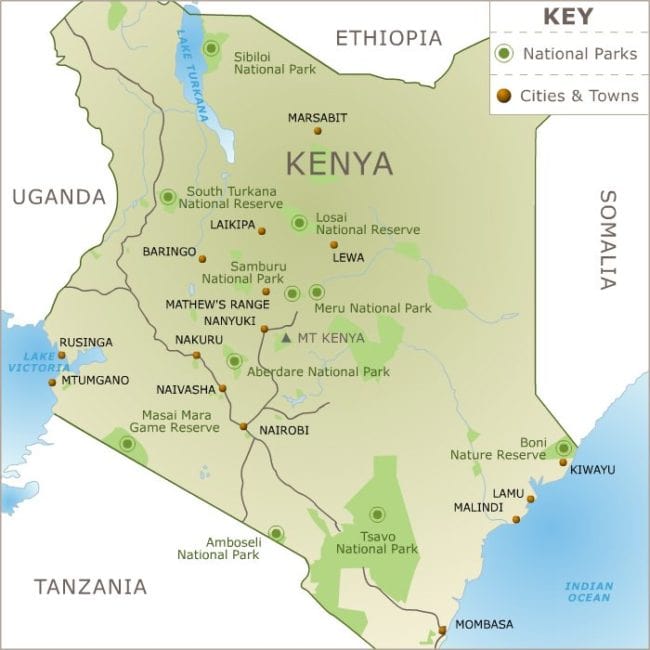
Map of Kenyan parks and reserves. Source
Me and my friend Edwin had already been to Mt. Meru and the coast so that was not so much an option for me. He had also already been to Tsavo National Park. Going up north was possible but it would have required much longer travel time and higher costs, or a day’s trip via Nairobi. We wanted to explore a different type of terrain and landscape and find somewhere quieter that was less popular than the Maasai Mara Game Reserve. Our Ker & Downey private guide, Howard, Founder of the Shackleton & Selous Society, suggested that we include Amboseli.
Amboseli is set on the southeastern border of Kenya with Tanzania. Ker & Downey lease a large amount of land from the local Maasai communities for exclusive use just outside of the National Park. This would mean that we would be the only ones in an area the size of a province and it would be unlikely that we would see any other visitors.
The landscapes and types of eco-system in Amboseli were also complementary to the Maasai Mara. The weather was remarkably cooler and drier than at the Maasai Mara and the flat plains made for large herds of elephants and giraffes. The park is also known for the dramatic views of Kilimanjaro that sits right across the border, in Tanzania. On a clear day, the wildlife can be observed against the backdrop of the majestic mountain I flew over so many times when I was working in east Africa.
The costs of reaching Amboseli were also lower than other parks. The park is about a 4 hour drive from Nairobi by car on a well paved road that takes you to the private conservancy area where Ker & Downey have set up their mobile camp. That would mean that we could save on the private charter plane while not adding too much extra travel time. Moreover, as the camp was technically set up outside of a National Park, I could fly my drone as the law prohibits you from flying it inside a park.
Lastly, as we would stay in the Conservancy area instead of the park, the local Maasai communities would still be living in the area, letting their cattle graze, going about their regular life and generally mingling with the guests. This was the perfect opportunity to have a cultural exchange that would be bound by some touristy activity. Howard’s right hand man, Solomon, an elder Maasai from the local village right next to the camp, would take us to his village and show us around. Under his guidance, we would get to know real life in Kenya, interact with his family, visit his village, the local school and enjoy an afternoon with the Maasai, learning more about their warrior skills and traditions. We would not feel detached, being a mere spectator of the wildlife without interacting with the local culture, but rather be a part of it, just like when we travel to all other countries.
This was the perfect park for us. Quiet and exclusive, easily reached by car, culturally rich and distinct from the Maasai Mara Game Reserve. So we were convinced. All we need to do is get our safari packing list ready.
Our Kenyan itinerary
Howard suggested three nights at Amboseli and three nights at the Maasai Mara Game reserve. We would drive to Amboseli from the airport in Nairobi, charter a private plane from Amboseli to the Maasai Mara and take a scheduled flight back to Nairobi.
We added one final night in Nairobi for nostalgia’s sake. Both Edwin and I had spent a long time working in Kenya. In fact, Nairobi was our first trip in our over four years of working across East Africa, starting in December 2006. we used to stay at the Hilton Hotel, a decrepit and rather grey place that allowed us to accumulate miles with which I spent a week at the Conrad Rangali, in the magical Maldives. Other than that, the hotel was undesirable. The common areas, particularly the bar, were always brimming with prostitutes who would chase my colleagues up to their rooms, and the hotel was dated and falling apart.
Later on, in 2008 and 2009 we swapped the Hilton for The Norfolk Hotel, an institution and one of the first hotels to open in Nairobi. Fairmont acquired The Norfolk Hotel which is now branded with the international chain’s name. Spending an evening there, having a drink at the colonial bar and getting stuck in traffic on our way to the equally nostalgic Carnivore Restaurant, was a must. Even for just a few hours we would relive those year, the ones that I consider the best years of my life.
What to do in Amboseli
As we were staying in the Conservancy area our choices for interaction with the local Maasai communities was much higher. In Amboseli we could go on the regular game drives in search of wild game or go out on foot with Solomon and Matito, the two Maasai that work with Howard, trying to spot wildlife tracks on the dusty earth. Here are a few of the things we did in Amboseli.
1. Game drives
Game drives are the core of any safari. Comfortably seated on your open top 4×4 car, you follow, look for and observe wildlife. The idea is simple but the quality of the guide at spotting game is critical in having a great experience. To the untrained eye of a visitor, cheetah blend into the tall dry grass, lions hide behind the dried leaves, antelope are invisible laying on the fields. Every time that either Matito, Solomon or Howard spotted an animal in the distance, I was as surprised as I was puzzled, I could not see anything. Even with the binoculars it was hard for me to distinguish wildlife from the vegetation. I could not even tell animals from each other whereas the guides could all immediately tell a zebra from a wildebeest from miles away.
2. Maasai village visit
If you are lucky enough to be staying with Howard and Ker & Downey then you have the chance to also spend time with Solomon, Matito and the rest of the Maasai crew. Solomon offered to take us to his village to meet his family and learn more about Maasai life which was a great way to see it for real without any touristy affairs, like it was just a simple visit at a friend’s house. His mother and one of his wives welcomed us into their huts and we toured the village, learning more about the cattle, the family structure and the ways of life. We then went to a local school where Solomon used to teach and met with the teachers and the kids as they were going about the day’s class.
In the evening, we gathered next to the camp to watch the Maasai practise their skills in what Howard calls “The Maasai Games”. The Maasai are well known warriors and very agile. A G&T was served with the entertainment while they competed at throwing spears trying to hit a plastic bottle, practised their dance and jumping moves and competed at a running race. It was a lot of fun to watch and incredible skills to witness.
3. Chasing spring hare
This was a somewhat interesting activity to partake in and something the Maasai do for fun. Spring hares are a combination between a kangaroo and a hare, no kidding. Try to imagine the way the animal would look in your mind and that is exactly how it looks. Long springy legs that allow them to jump around and then a head of a hare. They are small nocturnal animals so they only come out at night. As soon as we were done with dinner, we went out in search of these animals. As they came out of their barrows Matito and another of the young Maasai jumped out of the car and started running around in the bush trying to catch them. It was exhilarating to watch and incredibly unbelievable that they did, almost on every occasion.
4. Walking safaris
What makes Amboseli Conservancy area quite unique and different from the Amboseli National Park area, is that you can go out on a walking safari with the Maasai as escorts and expert guides. Inside most parks in Kenya, walking safaris are usually not allowed for safety reasons, but this is an area where the Maasai live in harmony with nature and so they take their cattle out to graze between the elephants and the hyena. We went out on foot from the tent into the bush looking for tracks of various herds and predators and it was refreshing and different to be on foot, a very distinct perspective on the African savannah.
5. Bond fire tales
My favourite time of the day out in the bush is the evening, before dinner, when the stars are lighting the sky and the fire is burning. Sitting around the fire on the typical safari foldable chairs in that khaki green colour, with a gin and tonic in your hand, some dried biltong and only the tales and stories of the bush as company, the world seems to be so vast. At lodges, these moments have been the source of many an idea for a next trip from fellow safari goers.
6. Watch the Milky way
The first time I saw the Milky Way I was in Pilanesberg Park in South Africa. We had decided to go on a safari for the weekend as we were there on a project and Pilanesberg was an easy to reach reserve. At night, as we went on a bush dinner in the middle of the savannah, I looked up and it was right there in plain sight, just above our heads. It was just so clear that I thought it could not be true. Having seen it so many times on TV and on pictures I couldn’t believe its beauty in real life. Away from the light pollution of the cities, any safari will give you the chance to see the Milky Way using with the naked eye.
What to do at the Maasai Mara Game Reserve
Whereas in the Amboseli conservancy area you can roam around among Maasai villages relatively free, inside the Maasai Mara Game Reserve the rules are stricter and the traffic higher. The Maasai Mara Game Reserve is a 1,500 sq km protected area that forms a continuum from Tanzania’s Serengeti, five times bigger. Its name comes from the Maasai people who inhabited this ancestral land, and the word Mara means “dotted” to refer to the various one off bushes, trees and acacias that dot the reserve.
1. Spot the Big Five
As opposed to other parks across Africa, the Maasai Mara Game Reserve is home to all the Big Five, including the elusive leopard and the endangered rhino, which are truly hard to spot. Large herds of zebra and various antelope can be seen at all times, even outside of The Great Migration period, and wildebeest have been estimated in the million between the Maasai Mara and Serengeti. Crocodiles and hippopotami fill the waters of the various rivers, most notably the Mara River, and can be spotted pretty much on every river bank. Predators are also in large numbers, with lions roaming freely and easily seen at all times of the day, especially during the early morning and evening.
Because of the wealth of wildlife and variety that can be found in the Maasai Mara, numerous research projects are always ongoing in the area. When spotting cheetah, the cheetah conservation project cars will be around making sure guides don’t get too close. As a popular and well catered for park, the Maasai Mara has three airport strips inside the park boundaries and another three in the conservancy area making it an easier and cheaper to reach park from Nairobi by plane.
The landscapes of the Mara are easily recognisable. Flat plains dotted by lone trees or bushes and dissected by the three rivers give the area a peculiar outlook. Wildlife is so abundant that it feels at times that the animals are not scared at all of humans. Poaching has almost been eradicated with the constant patrolling of the park rangers and the ongoing presence of tourists. As a result, one can get really close to wildlife as the animals don’t run away as they do in other parks.
2. Go on night drives
Although there are a lot of tourists in the park at all times, night drives give a special insight into life in the savannah. Some of the nocturnal animals, like monkeys and owls, come out to play and can be easily spotted without any other car in sight.
3. Search for The Great Migration
Most people visit the Mara in search of The Great Migration. Be it during the February to March season or the June to September period, this is a once in a lifetime sight to behold but it may require a lot of patience. Large herds of wildebeest and zebra will start congregating close to the river bank, testing for an adequate crossing. In the usual work of a herd, more and more animals will get closer, following their fellow wildebeest. At some point there will be a lot of them, thousands at a time, all congregating by the river crossing. Until the first brave animal will start running toward the water or shyly descend into it. Then, as if pulling a string all the rest of the wildebeest were holding, the rest of the herd will follow.
Dust will fly everywhere, water and mud will be splashed and thousands of wildebeest and zebra will cross the river to the other side. Many of the little ones will not make it, they will miscalculate the jump up the other shore and die of exhaustion, drowning in the brown waters of the Mara River. Some unlucky ones will be eaten by the crocodiles in the ever famous image of The Great Migration. Others will return back to the shore, and try crossing another day. But most will make it to the other side and continue their grazing trip towards greener fields.
- Check if you need a visa, get help processing it at iVisa.
- Never ever leave without travel insurance. Get affordable coverage from World Nomads or long term insurance from Safety Wing.
- I find all of my flights on KAYAK. Check their Deals section too.
- Search for all your transportation between destinations on the trusted travel booking platform Bookaway.
- I book all my day trips and tours via GetYourGuide, they are the best and their tours are refundable up to 24h in advance.
- Get USD35 off your first booking with Airbnb.
- Compare hotels EVERYWHERE at HotelsCombined and book with Booking.com.
- Compare car rental prices at Rentalcars.com

